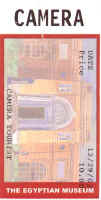


Herodotus, the 5th century Greek historian and Egyptian tourist, is often quoted saying "Egypt is the gift of the Nile." His observation wasn't entirely obvious to us on our first day. There's no doubt that Herodotus was correct, but our mission for the day was the Egyptian Museum and the Great Pyramids. The Nile was ruling the day, but only just beginning to come into our field of vision.
In the picture above, we're standing in front of the reflecting pool in front of the Egyptian Museum. We had paid our "Camera fee" and were waiting for our guide to finishing the parking odyssey (plenty of traffic!). The crowds were mostly Italian, French, and German, with very little English heard. The pond was home to papyrus and lotus, symbols of the upper and lower Egypt. Little did we appreciate how much we were already under the influence of the "gift!"
Cairo's Egyptian Museum is the best place on Earth to see the Egyptian antiquities, although not the only place. Napoleon's Egyptian campaign of 1798 gave birth modern attempt at Egyptology. In those years, colonialists made off with the plunders. Napoleon's campaign lead to the discovery of the Rosetta Stone which eventually became the key to deciphering hieroglyphs. The British eventually prevailed over Napoleon in Egypt, and sent most of his discoveries to London where the Rosetta Stone is now located. When we first entered the museum, our guide pointed out a replica of the Rosetta Stone that "was kindly provided by the British to help absolve their guilt."
As Egypt became more established in the Western world, rules were established on divvying up the loot. By the time Howard Carter found King Tutankhamen's undisturbed tomb in 1922, Egypt was claiming title of most antiquities. Thankfully, trinkets from much of Egypt's rich history are now organized on display at the Egyptian Museum. With only 1/2 a day in the museum, we felt rushed. There was so much to see! After all, Egypt was the first nation in history with the first ever historical documents (Narmer's Palette, 3200BC).
Below are some examples of things we saw in the museum. The picture on the right is the back of a coffin covered in hieroglyphs. Turns out that hieroglyphs are phonetic, not ideograms as you might expect from the "pictures." Of course, sounding out the words doesn't do much good unless you also understand ancient Egyptian. Thankfully, it's all been pretty much decoded. Some of the ancient words are funny. For example, the Egyptian word for wine sounds like a burp! You can transliterate your own name with the decoder shown below. If you write your name inside an oval shaped "cartouche" (French word for bullet), it suggests that your name is royal. This is the origin of the cartouche jewelry craze, and of course, the girls purchased cartouches during our visit.
The coffin scene also includes an image of the winged Isis god. The stela scene on the right includes an image of the god Amon-Ra (falcon man with sun on head). The young lady on the right is dressed in her finest giving tribute. Notice the red blob on the lady's head: it's a mixture of fat and lotus oil that slowly melts into her wig giving a perfume effect. Also notice the lotus flowers on the offering table and the "waset" staff in Amon-Ra's hand.
There are hundreds of gods in Egyptian mythology with multiple cosmologies. According to some versions of the creation myths, the cosmos gods first appeared in male and female pairs: Hok and Hoket, representing formlessness, Kuk and Kuket representing darkness, Amon and Amonet representing hidden-ness, Nun and Nunet representing the primordial waters. The god Atum (sun) created himself on a hill that rose out of the primorial waters. Then, Atum (or Aten) created, Shu (air) and Tefnut (moisture). Shu and Tefnut begat Geb (earth) and Nut (sky). Geb and Nut give birth to two married pairs: Isis & Osiris, and Seth & Nephthys. Seth is the evil one! Isis and Osiris descend to earth and civilize Egypt which eventually culminates in a fight with Seth. Osiris falls victim to Seth's evil and becomes the first resurrected mummy. Hence, Osiris is the god of the dead. Eventually, Isis gives birth to Horus, who later defeats his uncle Seth. . .but Seth doesn't die because evil is always remains with us! Pharaohs were considered gods on Earth and frequently associated their names with these mythical gods.
Of course, there are dozens of other lesser gods. For example, there's Anubis the mummification god with the head of a jackal, there's Sobek the crocodile headed god present at a person's final judgment, and there's Toth the ibis headed god who is the patron of scribes and doctors. There's no lack of deities! It's also thought provoking that many gods were worshiped in trinities of father, mother and child. A good example is Isis, Osiris, and Horus.
Oddly enough, the Egyptian Museum's most precious artifacts trace back directly to Akhenaten, the monotheistic heretic Pharaoh. Akhenaten's birth name was Amenhotep IV (meaning the god Amon is pleased). Despite over 2000 years of tradition, he radically declared there was only one god: Aten. He changed his name to Akhenaten. It's a long story, but his declaration meant really big change, something that hadn't ever happened in Pharaonic times. The divine order, or "Maat" was profoundly disturbed. Akhenaten died in his 17th year of reign at his purpose built Holy City, exiled from Thebes, the traditional religious center. His heir was the boy King Tutankhamen, also known as "King Tut."
King Tut married his royal relative at a young age to become the Pharaoh. Being young, King Tut probably ruled under the direction of his vizier, Ay and his military chief Horemheb. They restored the traditional deities and reinstated a royal presence at Thebes and Memphis. Some believe that King Tut was murdered at about age of 17 or 18, probably because Ay wanted to take the thrown. There's a theory that Ay forced himself on the widowed queen to become the succeeding Pharaoh. Ay only ruled for 3 years and was followed by Horemheb. Horemheb subsequently tried to erase all traces of Akhenaten, King Tut, and Ay.
King Tut's tomb was hurriedly prepared on the 70 day deadline for mummification. The entrance to his small tomb was located among many others in the Valley of the Kings. Ancient thieves made several attempts to rob the tomb, but the priests managed to keep it largely intact and sealed. In succeeding years, other tombs were built nearby, and the entrance to Tut's tomb was buried in debris. It was forgotten until rediscovery and excavation in 1922.
Above are some pictures of the many treasures on display at the Egyptian Museum. King Tut's death mask is breath taking and the alabaster oil jars are stunning. The cobra and vulture on the head of King Tut's coffin mask represent protectorates of the upper and lower Nile. His coffin is an incredible artwork in solid gold that weighs 250 lbs! One can only imagine what must have been in the tombs of the greater pharaohs!
After our curt immersion in Pharaonic history, we emerged into the real world traffic jam of modern Cairo. Our guide skillfully vectored our driver towards a local "papyrus museum" craft shop. It was probably a brother-in-law kickback deal, but we didn't find it necessary to judge anyone's pecuniary motives. It was simply a fun and fascinating shopping adventure!
Above are some photos from our papyrus shop visit. On the left, Elizabeth is slicing some papyrus reed as the first step of making papyrus paper. On the right, Vijay is laying out cut strips for pressing. In the center, is a finished product from a local artist. It shows the "tree of life." The birds on the bottom right represent youth. The birds age in the counterclockwise direction. The top of the tree represents middle age, and the bird spreading its wings represents old age. Finally, the bird facing West represents death. west is the symbolic direction of the after life. Tombs, including the pyramids, were always on the West side of the Nile. It's no coincidence that dead folks were known as "Westerners."
Above are some of the spoils from the shopping adventure conquest. On the left is one our favorites: the "Final Judgment." The deceased enters the afterworld by the hand of Anubis whereupon the heart is weighed against a feather. If the heart should weigh too much, Sobek is standing ready "eat your heart out" and dismiss eternal afterlife for dinner. Meanwhile, Toth, the scribe, records the event. Overhead, bearded Pharaoh ancestors sit ready to hear sins and provide mitigating advice. Successfully beyond the scale of judgment, Horus guides the deceased towards Osirus via the entry into the eternal afterlife. Magic stuff!
Above on the right is another famous scene sometimes found on the ceiling of Pharoh's tombs or in temples. I think this was inspired by the tomb of Seti, father of Ramses the Great. The astronomical scene shows the sky Goddess, Nut, in a back-to-back pose with what might be considered the heavenly Nile flowing between her two backbones. The East side (top) represents earthly life, and the West side (bottom) represents is the eternal afterlife. In the evening, Nut swallows the sun and in the morning she gives birth to the sun to start the day anew. Imagine the stretch marks!
Indeed, the Nile had become our gift for the day! Join us for the end of our first day by clicking below.